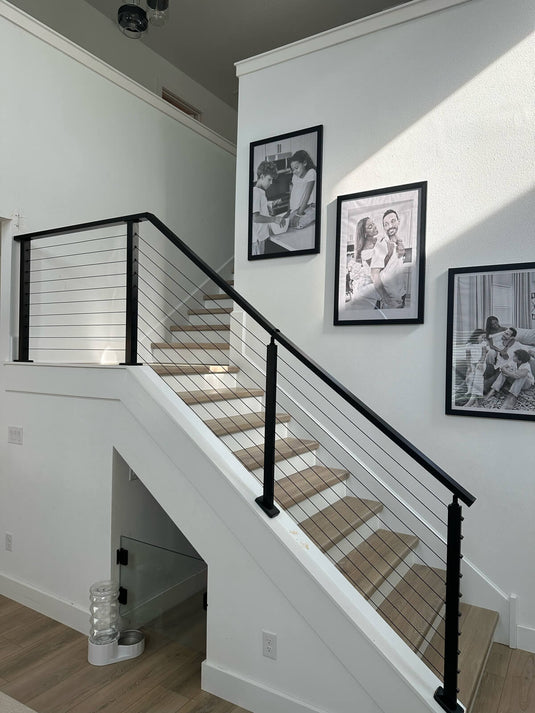TABLE OF CONTENTS
Enhance Your Railing with a Modern Cable Rail System - The Ultimate Guide
Introduction
Railings hold a significant role in both safety and aesthetic aspects of residential and commercial structures. Traditionally, railings were fashioned from materials such as wood, metal, or glass. However, in recent times, cable rail systems have emerged as a popular and contemporary option for enhancing railing designs.
Cable rail systems, also known as wire rope railings, employ stainless steel cables as the primary structural support. These systems offer an open and modern appearance while adhering to safety codes and standards. Within this comprehensive guide, we will delve into the essence of cable rail systems, and assist you in determining whether a modern cable rail system is the ideal choice for your railing needs.
What Is a Cable Rail System?
A cable rail system, as the name suggests, utilizes cables instead of conventional materials for railing infill. The cables, usually made of stainless steel wire rope, run horizontally between posts to form the barrier. The entire system is tensioned using fittings and tensioners to ensure the cables are taut.
In most systems, the top rail and bottom rail are also made of cable to complete the open, transparent look. The cable railings are supported by wood, metal, or composite posts anchored to the deck or flooring. Many systems have a framed glass panel option for the portion of the railing around the stairs.

Are Cable Rail Systems Worth It?
There are several compelling benefits that make cable railings well worth considering:
Architectural Aesthetic Cohesion
A defining hallmark of cable rail systems lies in their minimalist yet sophisticated architectural design. Comprising slender, high-tensile steel cables, these railings proffer a visually unintrusive view, thereby seamlessly integrating with contemporary architectural idioms. By eschewing visual obstruction, they permit surrounding architectural elements and environmental vistas to assume prominence, imparting a spatially expansive aesthetic.

Maintenance Efficacy
A salient advantage of cable rail systems is the nominal maintenance they necessitate. Constructed from stainless steel imbued with high corrosion resistance, these systems obviate the need for periodic protective treatments such as painting or waterproofing—a typical requirement for wooden alternatives. A simple, infrequent cleaning regimen suffices to preserve their aesthetic integrity over an extended lifecycle, thus minimizing the Total Cost of Ownership (TCO).
Structural Integrity and Durability
Cable rail systems distinguish themselves by their superior resilience and longevity. Engineered from high-tensile strength stainless steel, the cables resist mechanical wear, effectively eliminating the risks of stretching and slackening over prolonged usage. When properly installed and maintained, their structural integrity ensures a functional lifespan extending 20 to 30 years, thereby amortizing the initial investment over a more extended period.
Safety Compliance and Risk Mitigation
Safety constitutes a non-negotiable criterion in the evaluation of any railing system. Reputable manufacturers of cable rail systems prioritize compliance with, or exceeding, extant building codes governing guardrails and fall protection. When installed per manufacturer specifications, the tautness of the steel cables serves as an efficacious deterrent against unauthorized climbing and inadvertent falls.
Return on Investment (ROI) Analysis
The initial capital outlay for a cable rail system is often commensurate with premium wood or metal alternatives. However, its demonstrable durability and low maintenance requirements contribute to a lower TCO, thereby amplifying its long-term value proposition. These attributes substantiate the cable rail system as a viable long-term asset, thereby enhancing its ROI.
Installation Flexibility
For stakeholders with a penchant for DIY endeavors, cable rail systems frequently offer pre-fabricated installation kits inclusive of pre-cut cables and essential hardware. These facilitate a straightforward, self-managed installation. Conversely, for those opting for a turnkey solution, professional installation services are ubiquitously available.
To encapsulate, the confluence of architectural aesthetic appeal, engineered durability, stringent safety measures, and a favorable long-term value proposition renders cable rail systems a compelling investment. Their low-maintenance attributes further augment their investment merits by minimizing both temporal and financial upkeep commitments. With prudent material selection and expert installation, a cable rail system can unequivocally enhance both the functional and aesthetic parameters of your railing infrastructure.
When Should You Enhance Your Railing With a Modern Cable Rail System?
When considering a railing upgrade, cable systems make an excellent choice for many residential and commercial settings. Cable railings can enhance both form and function in specific scenarios:
- Contemporary Architecture - Contemporary, modern, and industrial architectural styles are defined by clean lines, simple forms, and an open feel. The transparent nature and thin cables of cable railings seamlessly blend with these aesthetics. They allow the interior design features to shine.
- Indoor Spaces - Atriums, stairwells, mezzanines, and other indoor locations often benefit from an unhindered view and lots of natural light. Cable railings provide a safe barrier while maintaining visual openness, unlike bulky wood or obstructing glass panels.
- Outdoor Views - Decks, patios, and balconies paired with beautiful vistas and landscapes make ideal spots for cable railings. The minimal cables don't detract from the views of rivers, forests, gardens, and other scenery.
- High-Rise Balconies - The lightweight cable materials put less structural load on elevated balconies compared to heavy glass or metal railings. This makes them suitable for high-rises.
- Rental Properties - For landlords, the low maintenance nature of cable railings adds convenience and saves costs. The cables are less prone to damage by tenants compared to wood railings.
- Design Accents - Adding cable railings allows homeowners and architects to complement them with other materials like stainless posts, tempered glass inserts, or LED lights for unique designs.
- Durability Requirements - Cable systems stand up well to outdoor weathering, resisting corrosion, stretching, and loosening over decades. Their longevity avoids frequent repairs or replacements.
- Child Safety - For spaces frequented by kids, cable systems with vertical wires added for safety help prevent children from slipping through horizontal cable gaps.

In many settings, a cable railing is a sleek choice to enhance the form and function of aging or lackluster railings. Their modern aesthetic and rugged durability make cable systems ideal upgrades in the right situations.
Conclusion
Modern cable rail systems offer a contemporary, low-maintenance way to enhance your existing or new railing. The transparent cables provide safety with an unhindered open view. Cable systems are worth the investment thanks to their aesthetic appeal, durability, strength, and easy installation. They are ideal for contemporary homes and structures with modern architecture and expansive views. With proper materials and anchoring, cable railings require minimal upkeep while resisting corrosion and loosening. For anyone seeking to update their railing with a sleek, durable cable system, following the tips in this guide will help create an enhanced look that lasts.
Q&As
Q: How much spacing is required between cable infill for safety?
Most building codes require a maximum of 4 inches between vertical or horizontal cables. This prevents children from slipping through wider gaps. Some systems offer a vertical cable option to complement the horizontal cables and meet safety gap requirements. Consult your local building codes for exact railing spacing standards.
Q: What are the most important factors when installing a cable railing system?
Proper tensioning of the cables is critical and should be done meticulously with a calibrated tension gauge. All cables must be uniformly taut without sagging. Use the correct strength anchors and base plates to securely attach posts. Follow all manufacturer specifications and building code requirements for installation to ensure safety and longevity. Consider having a professional installer if DIY installation seems daunting.
Q: How often should maintenance be performed on a cable railing system?
Cable railings require very minimal maintenance if quality components are used. Basic cleaning once or twice a year with soap and water keeps them looking new. Visually inspect tensioners, fittings, and anchors yearly to ensure there is no damage or loosening. Tighten any loose connections and apply touch-up paint on metal parts if needed. Re-tension loose cables every 5-10 years.
Q: What is the expected lifespan of a properly installed stainless steel cable railing?
Marine-grade stainless steel cable railings are designed to last 20 to 30 years or longer in most residential settings with proper installation and basic maintenance. Grade 316 stainless steel resists corrosion and retains its strength over decades, even in coastal salt air environments. With periodic re-tensioning and anchor upkeep, the cables can easily last 25+ years before any replacement is needed.




